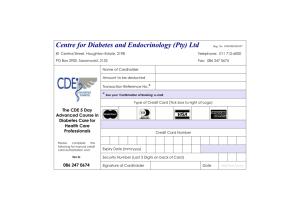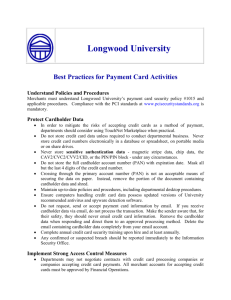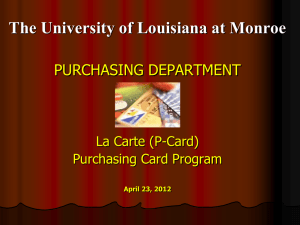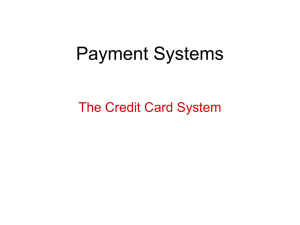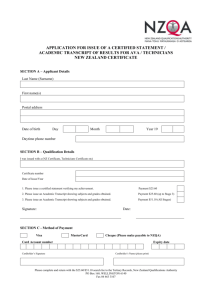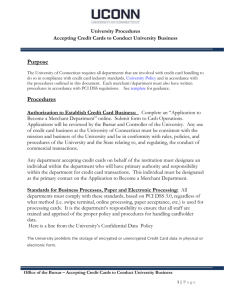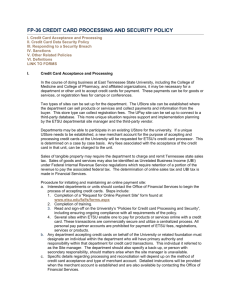You ask, we answer Form
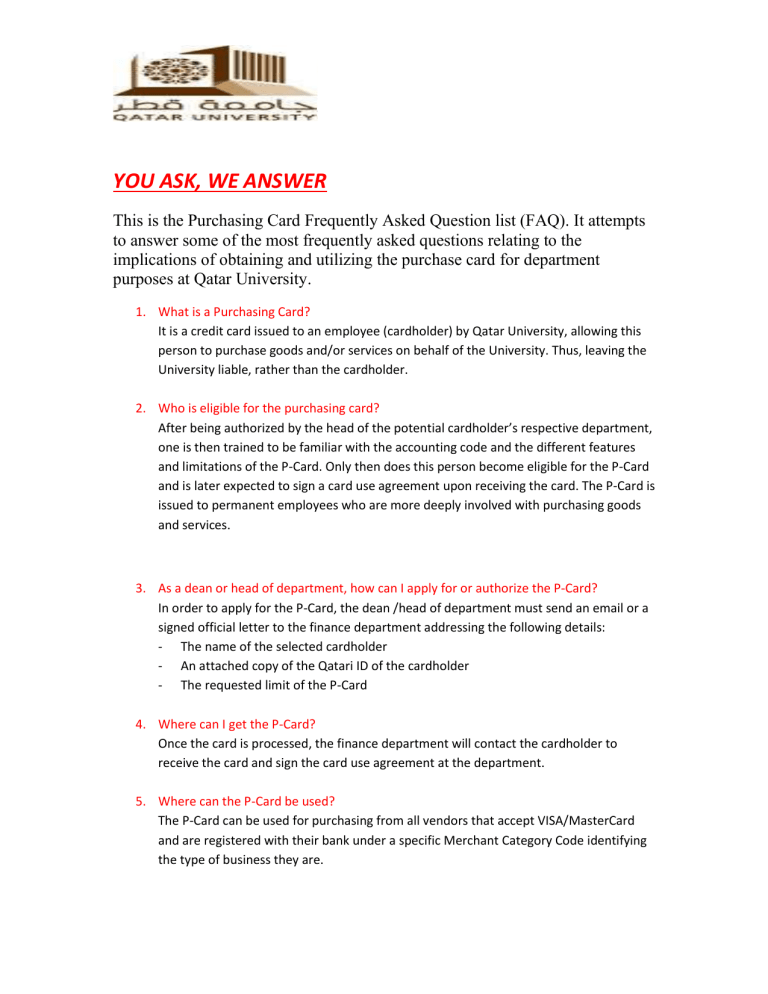
YOU ASK, WE ANSWER
This is the Purchasing Card Frequently Asked Question list (FAQ). It attempts to answer some of the most frequently asked questions relating to the implications of obtaining and utilizing the purchase card for department purposes at Qatar University.
1.
What is a Purchasing Card?
It is a credit card issued to an employee (cardholder) by Qatar University, allowing this person to purchase goods and/or services on behalf of the University. Thus, leaving the
University liable, rather than the cardholder.
2.
Who is eligible for the purchasing card?
After being authorized by the head of the potential cardholder’s respective department, one is then trained to be familiar with the accounting code and the different features and limitations of the P-Card. Only then does this person become eligible for the P-Card and is later expected to sign a card use agreement upon receiving the card. The P-Card is issued to permanent employees who are more deeply involved with purchasing goods and services.
3.
As a dean or head of department, how can I apply for or authorize the P-Card?
In order to apply for the P-Card, the dean /head of department must send an email or a signed official letter to the finance department addressing the following details:
The name of the selected cardholder
An attached copy of the Qatari ID of the cardholder
The requested limit of the P-Card
4.
Where can I get the P-Card?
Once the card is processed, the finance department will contact the cardholder to receive the card and sign the card use agreement at the department.
5.
Where can the P-Card be used?
The P-Card can be used for purchasing from all vendors that accept VISA/MasterCard and are registered with their bank under a specific Merchant Category Code identifying the type of business they are.
Using the card under a different partnering merchant to the supplier is STRICTLY
FORBIDDEN. In any case of card rejection, the cardholder must contact the Finance
Department – Help Desk at 44033111.
6.
Where should the P-Card NOT be used?
It is strictly forbidden to use the P-Card for the following:
Research grant activities or Special Funds (contact office of Academic Research)
Personal use
Purchasing from campus storerooms (Central Stores, Medical Storeroom), as they are not credit card vendors
Capital equipment with a unit price exceeding 20,000
Furniture, IT equipment, Audio Visual equipment software
Travel and all related payments
Employee expenses while travelling. They include but not limit to: o Airport shuttles o Automobile rentals and replacement fuel o Hotel rooms and services o Payment and reserving of hotel rooms o Parking o Per diem allowance o Personal or University vehicle fuel o Tolls/Taxes o Taxi Cabs
Chemicals, unless specific approval is guaranteed
Purchases from University employees, their spouses, parents or children
Purchases from business concerns of which an employee (or an employee’s spouse, parent(s) or children) is a sole or principal owner, major office, or primary employee
Purchases when the vendor requires an agreement or any contract to be signed by an authorized University representatives
Legal and arbitrary fees
Cash advances
Gifts to other University units or external organizations
Health Care provider fees
Independent contractor fees
Radioactive Materials
Trade-in of equipment that is inventoried
Weapons, ammunition, or detonating equipment or material
To request exceptional approval for conference registrations, airfares, bus fares and train fares, contact your dean or head of department.
7.
Can I use the P-Card to purchase consumable items like food, water or coffee related items?
It is possible
when necessary,
but you must check with the external relation first to make sure that it does not conflict with the nature of their work. And you must provide us with a justification for your purchase.
8.
How long is the P-Card valid for and how often should it be renewed?
All the cards have an expiry date, and it will renewed automatically. And the cardholder should remind the finance department one month before the expiry date.
9.
What is the maximum transaction amount on a P-Card?
The maximum transaction amount is equal to the monthly limit of the P-Card. However, you may not exceed QAR 20,000 on one unit of capital equipment.
10.
Can a third party make purchases on behalf of the cardholder?
It is strictly forbidden for the cardholder to share or allow a third party to use the P-
Card. When necessary, a third party may be sent to pick up the items from the vendor; however, this person is not authorized to sign the credit card sales slip.
11.
Can changes be made to card limits or cardholder information?
Yes, completing a Transaction Limit Change Request form at the Finance Department can change card limits. Any changes of cardholder information are to be emailed to the
Finance Department treasury unit at the following email pcard@qu.edu.qa
.
12.
Can online purchases be made using the P-Card?
Online purchases are allowed. However, it is under the responsibility of the cardholder to ensure that the website is secure [look for the https in the URL or a closed lock at the bottom on the bottom of your screen]. It is also under the responsibility of the cardholder to provide itemized receipts or order confirmation.
Third party services i.e. PAYPAL may be used under the complete responsibility of the cardholder. Cardholders are required to submit confirmation of payment from these
services as well as documentation about the order from the original vendor. The order information from the original vendor must match the payment information from the third party purchasing service.
The new P-Card is issued to you once you complete the related training session and sign the card use agreement. The renewal of the card occurs automatically and annually and nothing else will be required by you to continue from year to year.
13.
In what cases would the P-Card be terminated?
A card is closed out and returned to the finance department for termination in the following cases:
The termination of the cardholder’s employment
The transfer of the cardholder to another department
An inactive card (a card that has not been used for 12 months)
14.
Where should the P-Card be kept?
Although it is not compulsory, it is recommended that the P-Card is stored in a locked office at all times. However, this is a must for cardholders on vacation, as the card remains under the cardholder’s complete responsibility.
15.
What items or services can be purchased using the P-Card?
Before making a purchase using the P-Card, the cardholder must check if the item is available on the University Term Contract, and if not, the cardholder is responsible for ensuring that it is the best value for the selected item. It is also under the responsibility of the cardholder to provide itemized receipts for the purchase.
The University Contract can be found at the procurement home page.
16.
What are the procedures for authorizing P-Card transactions?
You should follow the proper internal procedures set up specific to your department in addition to:
Determining whether the P-Card is the most appropriate tool to use for the purchase
Determine the total amount (shipping, handling, insurance, etc.) and making sure that it does not exceed the maximum single transaction amount or total monthly
limit set on your card. You must contact the Finance Department within 24 hours if you are unsure why your card has been rejected.
Obtain a priced, itemized receipt at the time of purchase or pickup. All original receipts and paperwork must be forwarded each month with an approval hard copy statement to the Finance Department – Treasury unit. Random checking and audit might be performed at any time the cardholder and/or reconciler will be accountable for discrepancy
17.
How can I make purchases by phone, fax and mail?
In the case of making a purchase by phone, fax or mail, it is the responsibility of the cardholder to ensure the availability of an itemized receipt and/or a packing slip that shows the CURRENCY AMOUNTS. The cardholder must provide the supplier with his/her
name, department or address, phone number and complete delivery instructions. We recommend that you have your purchases shipped to your campus. However, if you decide to use the Qatar University Central Receiving Warehouse, please use the following address:
Qatar University,
Central Material Stores,
Al-Daphna, University Street
P.O. Box: 2713
When making a phone purchase, the cardholder must make a transaction log, using the following template: http://bit.ly/transactionlog
When making a fax purchase, the cardholder must keep copies of all faxes. Avoid
sending copies to the vendor as this may lead to duplicate shipping. If the company requires the original the cardholder must mark it “CONFIRMATION OF FAX ORDER, DO
NOT DUPLICATE”.
When purchasing by mail, the cardholder must be sure to keep copies of all sent and received mail (records, receipts etc.)
18.
What if the supplier accidentally makes a duplicate shipment?
Any duplicates shipments are the responsibility of the cardholder; it is also the responsibility of the cardholder to resolve the issue with the vendor.
19.
What are the procedures and requirements for returns?
Items purchased with purchase cards may periodically need to be returned for any reason that should occur. It is recommended for the cardholder or corresponding department to keep boxes or any form of packaging, to keep important phone numbers or instructions for return.
In the case where a restocking fee must be paid, the cardholder can use the P-Card to perform this transaction, but must keep a record of the transaction.
DO NOT accept checks, cash or cash equivalents (i.e. gift cards) for any returns. If you used your P-Card to make the purchase, be sure to have a credit for any return applied to your card. You will need a copy of the credit memo for your records and documentation.
20.
What are the procedures for postal purchases?
Postage is allowed on the P-Card. This includes stamps, priority, and express mail. All receipts must be documented with the business purpose whether you are purchasing a single stamp, a roll of stamps or sending a letter or package certified or priority mail.
Receipts are required to be priced and itemized. Please see business purpose described below:
The post office does provide detailed receipts and labels with destination, which should be obtained at the time of your purchase and submitted with your P-
Card statement. Your bulk mail should continue to be processed by University
Mail Services. For more information on bulk mail, please contact Business
Operation Department- Mailing Section.
Express shipping is allowed on the P-Card. This includes UPS, FedEx, and DHL. All receipts must be priced, itemized, show destination, and must be documented with the business purpose.
A “to/from handwritten label” that is not accompanied by the vendor’s priced; itemized receipt is NOT complete documentation.
The business purpose needs to be detailed yet with generalities. Stamps for the office, for example, are too broad. Please explain the types of mail sent out (registration documents) and to whom (students, research participants, etc.) it is mailed. An acceptable business purpose would be, for example, mailed course disks to students in
Math XYZ. Transactions not properly documented will be considered violations of P-Card policy.
21.
How many days from purchase can a transaction be disputed?
Purchases appearing on a monthly statement from the bank can be disputed within 60 days from the date of the statement. The cardholder may contact the vendor to resolve any issues with purchases appearing on the statement. If the issue continues and the cardholder is not satisfied with the vendor’s response, the cardholder may contact the
Finance Department where he/she will be required to fill a statement of disputed item.
22.
What are the processes and procedures of reconciliation?
Reconciliation of purchases by the cardholder is the final step in the purchasing card process. It is also one of the most important steps because this is where the cardholder verifies the legitimacy of the purchase and provides itemization and pricing of all items purchased. The statement cycle ends on the twenty-eight (28th) of each month, and cardholders receive statements about four to ten working days after this date.
Approved cardholder statements with all documentation are due to the Treasury Unit on or before the 20th of the month following the close of the billing cycle.
If any statement is not received by the due date the P-card is subject to suspension.
Expense online application:
The cardholder and/or Reconciler will be to fill out a web based statement through an application called I-expense.
Access provided by the bank:
The current system in the bank does not allow cardholders to access the P-Card online only the finance department personnel are allowed for such access. However, the cardholder can ask to be provided with P-card statement at any time by contacting the
Finance Department – Treasury unit.
Each cardholder receives an individual printed statement from the bank, which lists all activity for the month. This statement follows the format used by most banks and is straightforward and easy to follow.
Documentation and Review:
Original, priced itemized invoices/receipts are required for each purchasing card transaction, and are to be attached in order behind a monthly credit card statement.
These receipts are used to describe what was purchased, to verify transaction amounts, and to document the business purpose served by the purchase.
Itemized invoices/receipts must provide the following details:
Vendor
Description of item(s) and quantity
Price
Tax, shipping, or freight
Total transaction amount
Order confirmations for online orders are acceptable IF all the information referenced above is presented.
If a vendor’s invoice/receipt only lists a part number, the cardholder is responsible for including descriptive information and/or writing a brief description beside the part number so that anyone reviewing the documentation will know what it was the cardholder purchased.
Receipts for food and all other consumable items must be itemized, and documented with the business purpose and funding source.
23.
What are the responsibilities of a cardholder during reconciliation?
The cardholder should contact the vendor to resolve any discrepancies when possible.
Any fraudulent charges should be reported immediately to the Finance Department –
Treasury Unit to begin the dispute process.
Cardholder responsibilities also include the following:
Review all charges on the monthly hard copy statement to determine that the charges are correct.
Reconcile the monthly statement with receipts. There should be an original, priced receipt for every transaction. The total showing on the receipt should match the transaction amount printed on the cardholder’s statement to within a QAR1.00 difference only.
Put itemized receipts in order as listed on the statement.
Tape small receipts on letter size paper. DO NOT cover detailed information with tape.
Attach one copy of any shiny receipts (printed on slick, thermal type paper) to the original receipt.
Staple receipts to the upper left hand corner in back of the statement.
Sign statement and forward to your reconciler.
24.
What are the responsibilities of a reconciler during reconciliation?
The reconciler:
Must review and approve each cardholder’s account on a monthly basis.
Review the cardholder’s statement and receipts to ensure they are in compliance with P-Card policies and procedures.
Make sure all receipts are itemized with pricing for every transaction and in order as they appear on the cardholder’s statement.
Make copies to be maintained by the department according to record retention guidelines.
Report any unusual cardholder spending or discrepancies to the Finance
Department
Note: If the cardholder and the reconciler are the same individual, the department head must countersign his/her approval of the statement. Also, in the case where a departmental reconciler reports directly to the cardholder as in when a Director/Dept.
Head has a card, the cardholder’s superior or someone at the division level should be appointed to sign off on the cardholder’s purchases. In this case the statement would require three (3) signatures. If you are not sure how to resolve your situation, please contact the Finance Department Help Desk for guidance.
25.
What are the responsibilities of a P-Card administrator during reconciliation?
The QU Staff, in Finance Department, is responsible to:
Enforce P-Card policies and procedures and provide P-Card participant’s updates as needed.
Review transactions and receipts for compliance QU P-Card rules and regulations.
Random Audit for completeness and adequacy of receipts documentation, however, cardholders and reconcilers are accountable for any misappropriation of any transaction.
Prepare and process statements for audit on a timely basis and ad-hoc basis.
Provide support and assistance and act as bank liaison for cardholders and reconcilers; for example, when a statement is not received or when a transaction is declined.
Cancel cards or suspend cards to enforce policy.
Process new and replacement cards.
Download and verify the bank file monthly.
Provide P-Card training.
26.
Where should statements and receipts be sent for P-Card transactions?
All original statements and receipts should be se sent to the Finance Department –
Treasury Unit each cycle. It is under the responsibility of the cardholder to retain all
documentation copies and to ensure that the Finance Department receives them. Any discarded P-Card documentation is to be destroyed by shredding to protect sensitive information.
Original documents will be archived for a period of (5) years in the University archives.
27.
What are the consequences of P-Card misuse?
Fraudulent or willful misuse of the card, including the willful use of the card to make personal purchases even if you intend to reimburse the University, may be cause for immediate cancellation of the P-Card privileges and may result in disciplinary action, up to and including termination of employment.
28.
In what cases should a P-Card be suspended?
P-Cards may be suspended or cancelled if any of the following occur:
Fraud or personal use
A pattern of violation of QU Purchasing and P-Card policies is documented, such as:
Splitting orders to avoid amount limitations in case of the capital equipment.
Noncompliance with Financial and Procurement policies and procedures
Delinquent statements
Incomplete statements/documentation
Misuse of funds
Unauthorized expenses
A card is determined to be of no use to the cardholder. A quarterly report is used to identify cards having no activity for a 12 month term.
The Finance Department – Treasury Unit will contact the cardholder to make sure he/she still has the card and to justify keeping the card account open.
Cardholders and Reconcilers will be required to attend P-Card Training upon accumulation of three (3) or more violations from any of the categories listed above during a six-month period. The card may be placed in a hold status until attendance at a class is documented.
Using someone else’s card, allowing others to use your card, and failing to secure your card are not allowed and may be cause for card cancellation.
Consistent abuse of the card is cause to place the card account in a hold status until a review can be conducted. Card abuse may be reason to cancel cards at the discretion of the QU Finance Department.
29.
What should I do in case of loss or misplacement of the card?
In the case of loss, the cardholder MUST IMMEDIATELY contact Qatar National Bank or the Finance Department to terminate the misplaced card. A replacement card will be issued once provided by the bank.
Still have questions? Please refer to Mr. Anas Al-Khamis at 44033121 or Mr. Hani Al-Azzazy at
44033151 or email pcard@qu.edu.qa
and we will return to you shortly. You can also use the click on the following link to submit your question online to the Finance Department.
